ENEG20001: Australian Engineering Practice Reflective Writing Task
VerifiedAdded on 2023/06/13
|7
|2265
|467
AI Summary
This reflective writing assignment delves into key aspects of Australian Engineering Practice, focusing on sustainable development, information management, and communication. The author reflects on the importance of sustainable practices, the need for engineers to consider both positive and negative impacts of their work, and the crucial role of information management in organizational success. Furthermore, the assignment highlights effective communication strategies, emphasizing clarity, simplicity, and the use of various communication tools to foster collaboration and prevent misunderstandings. The reflection also addresses the evolving landscape of engineering, including the need for engineers to adapt to changing social roles and embrace ethical considerations in their professional practice. The author draws upon personal experiences and academic sources to provide a comprehensive overview of these critical elements within the field of engineering.
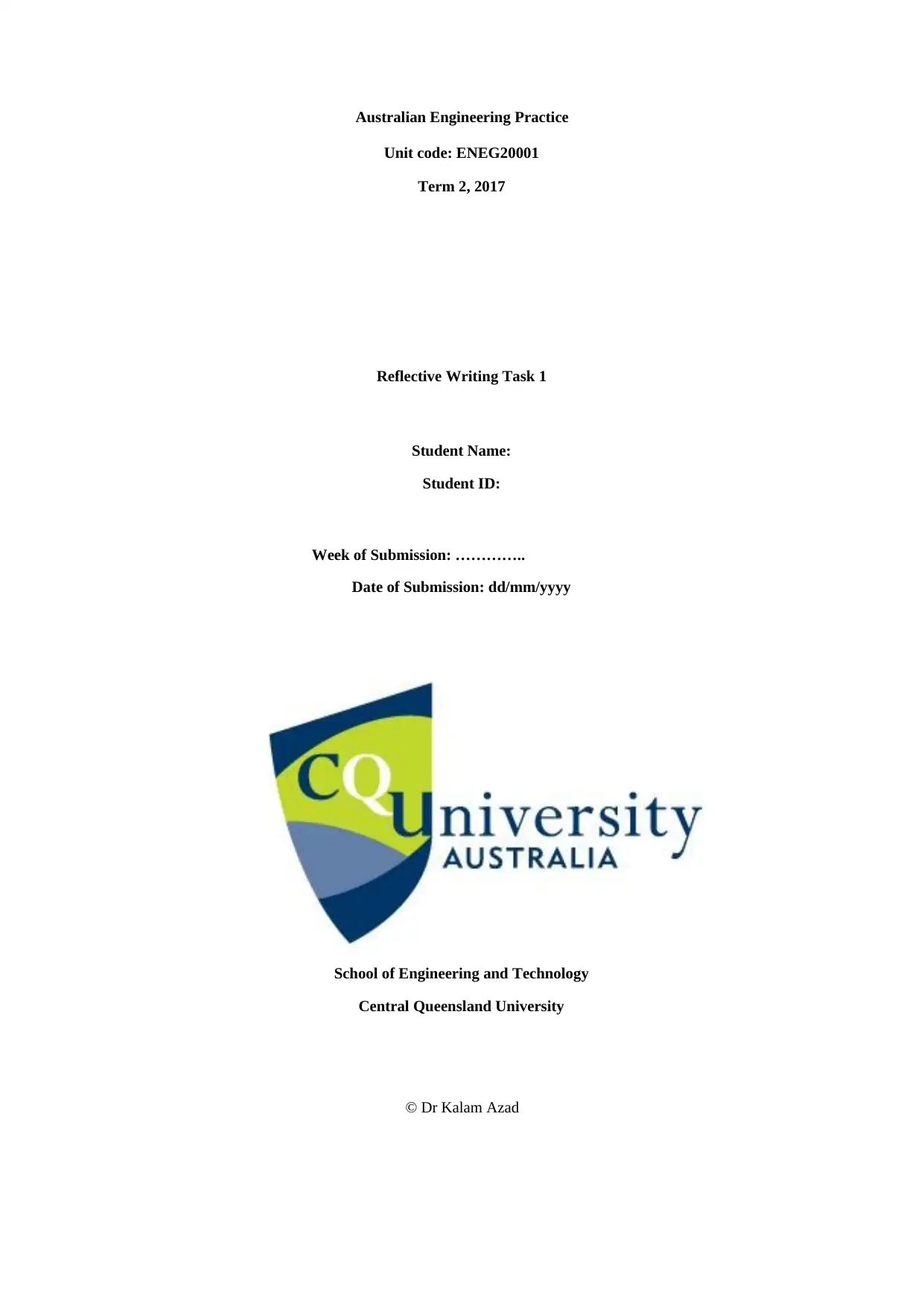
Australian Engineering Practice
Unit code: ENEG20001
Term 2, 2017
Reflective Writing Task 1
Student Name:
Student ID:
Week of Submission: …………..
Date of Submission: dd/mm/yyyy
School of Engineering and Technology
Central Queensland University
© Dr Kalam Azad
Unit code: ENEG20001
Term 2, 2017
Reflective Writing Task 1
Student Name:
Student ID:
Week of Submission: …………..
Date of Submission: dd/mm/yyyy
School of Engineering and Technology
Central Queensland University
© Dr Kalam Azad
Paraphrase This Document
Need a fresh take? Get an instant paraphrase of this document with our AI Paraphraser
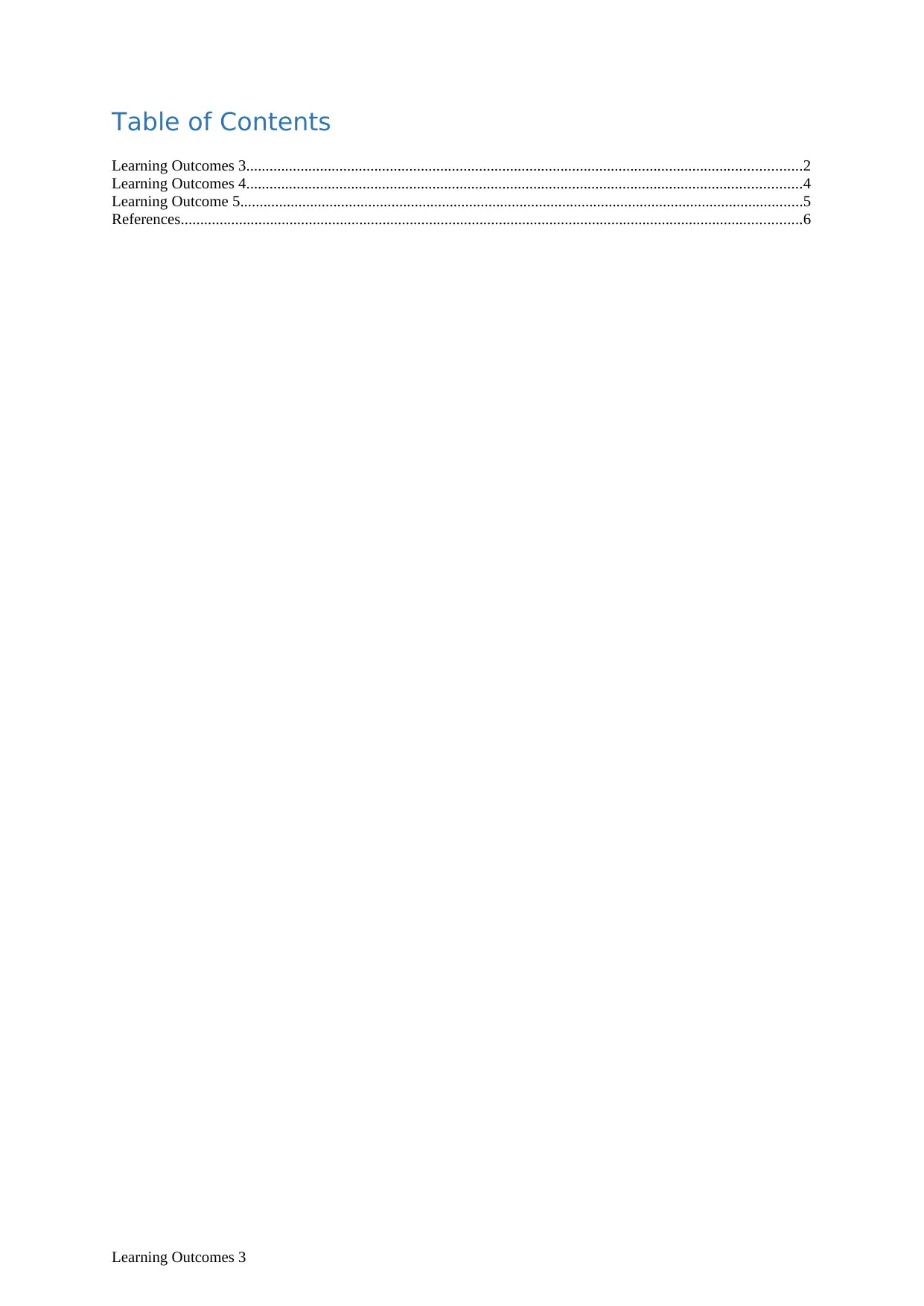
Table of Contents
Learning Outcomes 3...............................................................................................................................................2
Learning Outcomes 4...............................................................................................................................................4
Learning Outcome 5.................................................................................................................................................5
References................................................................................................................................................................6
Learning Outcomes 3
Learning Outcomes 3...............................................................................................................................................2
Learning Outcomes 4...............................................................................................................................................4
Learning Outcome 5.................................................................................................................................................5
References................................................................................................................................................................6
Learning Outcomes 3
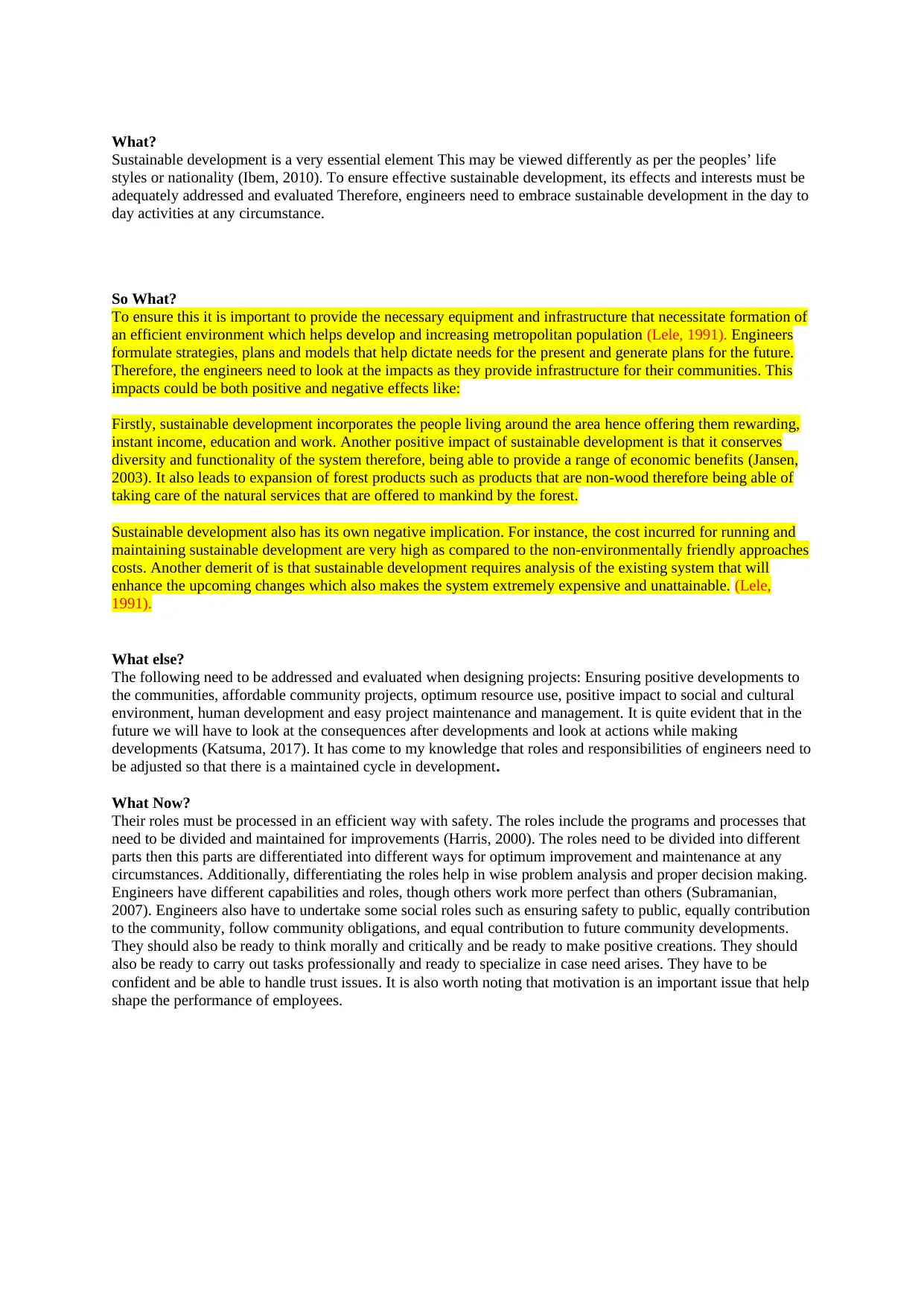
What?
Sustainable development is a very essential element This may be viewed differently as per the peoples’ life
styles or nationality (Ibem, 2010). To ensure effective sustainable development, its effects and interests must be
adequately addressed and evaluated Therefore, engineers need to embrace sustainable development in the day to
day activities at any circumstance.
So What?
To ensure this it is important to provide the necessary equipment and infrastructure that necessitate formation of
an efficient environment which helps develop and increasing metropolitan population (Lele, 1991). Engineers
formulate strategies, plans and models that help dictate needs for the present and generate plans for the future.
Therefore, the engineers need to look at the impacts as they provide infrastructure for their communities. This
impacts could be both positive and negative effects like:
Firstly, sustainable development incorporates the people living around the area hence offering them rewarding,
instant income, education and work. Another positive impact of sustainable development is that it conserves
diversity and functionality of the system therefore, being able to provide a range of economic benefits (Jansen,
2003). It also leads to expansion of forest products such as products that are non-wood therefore being able of
taking care of the natural services that are offered to mankind by the forest.
Sustainable development also has its own negative implication. For instance, the cost incurred for running and
maintaining sustainable development are very high as compared to the non-environmentally friendly approaches
costs. Another demerit of is that sustainable development requires analysis of the existing system that will
enhance the upcoming changes which also makes the system extremely expensive and unattainable. (Lele,
1991).
What else?
The following need to be addressed and evaluated when designing projects: Ensuring positive developments to
the communities, affordable community projects, optimum resource use, positive impact to social and cultural
environment, human development and easy project maintenance and management. It is quite evident that in the
future we will have to look at the consequences after developments and look at actions while making
developments (Katsuma, 2017). It has come to my knowledge that roles and responsibilities of engineers need to
be adjusted so that there is a maintained cycle in development.
What Now?
Their roles must be processed in an efficient way with safety. The roles include the programs and processes that
need to be divided and maintained for improvements (Harris, 2000). The roles need to be divided into different
parts then this parts are differentiated into different ways for optimum improvement and maintenance at any
circumstances. Additionally, differentiating the roles help in wise problem analysis and proper decision making.
Engineers have different capabilities and roles, though others work more perfect than others (Subramanian,
2007). Engineers also have to undertake some social roles such as ensuring safety to public, equally contribution
to the community, follow community obligations, and equal contribution to future community developments.
They should also be ready to think morally and critically and be ready to make positive creations. They should
also be ready to carry out tasks professionally and ready to specialize in case need arises. They have to be
confident and be able to handle trust issues. It is also worth noting that motivation is an important issue that help
shape the performance of employees.
Sustainable development is a very essential element This may be viewed differently as per the peoples’ life
styles or nationality (Ibem, 2010). To ensure effective sustainable development, its effects and interests must be
adequately addressed and evaluated Therefore, engineers need to embrace sustainable development in the day to
day activities at any circumstance.
So What?
To ensure this it is important to provide the necessary equipment and infrastructure that necessitate formation of
an efficient environment which helps develop and increasing metropolitan population (Lele, 1991). Engineers
formulate strategies, plans and models that help dictate needs for the present and generate plans for the future.
Therefore, the engineers need to look at the impacts as they provide infrastructure for their communities. This
impacts could be both positive and negative effects like:
Firstly, sustainable development incorporates the people living around the area hence offering them rewarding,
instant income, education and work. Another positive impact of sustainable development is that it conserves
diversity and functionality of the system therefore, being able to provide a range of economic benefits (Jansen,
2003). It also leads to expansion of forest products such as products that are non-wood therefore being able of
taking care of the natural services that are offered to mankind by the forest.
Sustainable development also has its own negative implication. For instance, the cost incurred for running and
maintaining sustainable development are very high as compared to the non-environmentally friendly approaches
costs. Another demerit of is that sustainable development requires analysis of the existing system that will
enhance the upcoming changes which also makes the system extremely expensive and unattainable. (Lele,
1991).
What else?
The following need to be addressed and evaluated when designing projects: Ensuring positive developments to
the communities, affordable community projects, optimum resource use, positive impact to social and cultural
environment, human development and easy project maintenance and management. It is quite evident that in the
future we will have to look at the consequences after developments and look at actions while making
developments (Katsuma, 2017). It has come to my knowledge that roles and responsibilities of engineers need to
be adjusted so that there is a maintained cycle in development.
What Now?
Their roles must be processed in an efficient way with safety. The roles include the programs and processes that
need to be divided and maintained for improvements (Harris, 2000). The roles need to be divided into different
parts then this parts are differentiated into different ways for optimum improvement and maintenance at any
circumstances. Additionally, differentiating the roles help in wise problem analysis and proper decision making.
Engineers have different capabilities and roles, though others work more perfect than others (Subramanian,
2007). Engineers also have to undertake some social roles such as ensuring safety to public, equally contribution
to the community, follow community obligations, and equal contribution to future community developments.
They should also be ready to think morally and critically and be ready to make positive creations. They should
also be ready to carry out tasks professionally and ready to specialize in case need arises. They have to be
confident and be able to handle trust issues. It is also worth noting that motivation is an important issue that help
shape the performance of employees.
⊘ This is a preview!⊘
Do you want full access?
Subscribe today to unlock all pages.

Trusted by 1+ million students worldwide
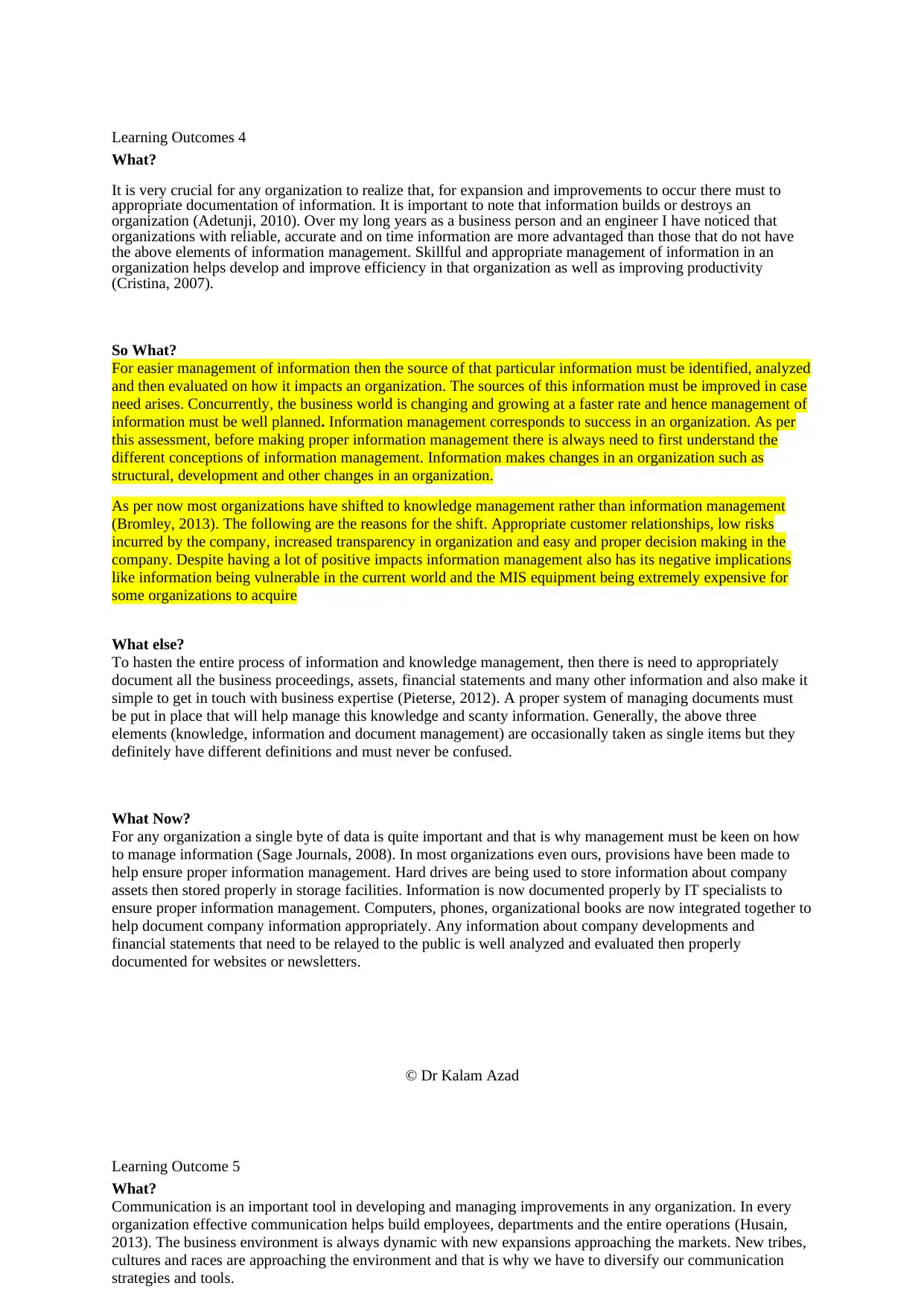
Learning Outcomes 4
What?
It is very crucial for any organization to realize that, for expansion and improvements to occur there must to
appropriate documentation of information. It is important to note that information builds or destroys an
organization (Adetunji, 2010). Over my long years as a business person and an engineer I have noticed that
organizations with reliable, accurate and on time information are more advantaged than those that do not have
the above elements of information management. Skillful and appropriate management of information in an
organization helps develop and improve efficiency in that organization as well as improving productivity
(Cristina, 2007).
So What?
For easier management of information then the source of that particular information must be identified, analyzed
and then evaluated on how it impacts an organization. The sources of this information must be improved in case
need arises. Concurrently, the business world is changing and growing at a faster rate and hence management of
information must be well planned. Information management corresponds to success in an organization. As per
this assessment, before making proper information management there is always need to first understand the
different conceptions of information management. Information makes changes in an organization such as
structural, development and other changes in an organization.
As per now most organizations have shifted to knowledge management rather than information management
(Bromley, 2013). The following are the reasons for the shift. Appropriate customer relationships, low risks
incurred by the company, increased transparency in organization and easy and proper decision making in the
company. Despite having a lot of positive impacts information management also has its negative implications
like information being vulnerable in the current world and the MIS equipment being extremely expensive for
some organizations to acquire
What else?
To hasten the entire process of information and knowledge management, then there is need to appropriately
document all the business proceedings, assets, financial statements and many other information and also make it
simple to get in touch with business expertise (Pieterse, 2012). A proper system of managing documents must
be put in place that will help manage this knowledge and scanty information. Generally, the above three
elements (knowledge, information and document management) are occasionally taken as single items but they
definitely have different definitions and must never be confused.
What Now?
For any organization a single byte of data is quite important and that is why management must be keen on how
to manage information (Sage Journals, 2008). In most organizations even ours, provisions have been made to
help ensure proper information management. Hard drives are being used to store information about company
assets then stored properly in storage facilities. Information is now documented properly by IT specialists to
ensure proper information management. Computers, phones, organizational books are now integrated together to
help document company information appropriately. Any information about company developments and
financial statements that need to be relayed to the public is well analyzed and evaluated then properly
documented for websites or newsletters.
© Dr Kalam Azad
Learning Outcome 5
What?
Communication is an important tool in developing and managing improvements in any organization. In every
organization effective communication helps build employees, departments and the entire operations (Husain,
2013). The business environment is always dynamic with new expansions approaching the markets. New tribes,
cultures and races are approaching the environment and that is why we have to diversify our communication
strategies and tools.
What?
It is very crucial for any organization to realize that, for expansion and improvements to occur there must to
appropriate documentation of information. It is important to note that information builds or destroys an
organization (Adetunji, 2010). Over my long years as a business person and an engineer I have noticed that
organizations with reliable, accurate and on time information are more advantaged than those that do not have
the above elements of information management. Skillful and appropriate management of information in an
organization helps develop and improve efficiency in that organization as well as improving productivity
(Cristina, 2007).
So What?
For easier management of information then the source of that particular information must be identified, analyzed
and then evaluated on how it impacts an organization. The sources of this information must be improved in case
need arises. Concurrently, the business world is changing and growing at a faster rate and hence management of
information must be well planned. Information management corresponds to success in an organization. As per
this assessment, before making proper information management there is always need to first understand the
different conceptions of information management. Information makes changes in an organization such as
structural, development and other changes in an organization.
As per now most organizations have shifted to knowledge management rather than information management
(Bromley, 2013). The following are the reasons for the shift. Appropriate customer relationships, low risks
incurred by the company, increased transparency in organization and easy and proper decision making in the
company. Despite having a lot of positive impacts information management also has its negative implications
like information being vulnerable in the current world and the MIS equipment being extremely expensive for
some organizations to acquire
What else?
To hasten the entire process of information and knowledge management, then there is need to appropriately
document all the business proceedings, assets, financial statements and many other information and also make it
simple to get in touch with business expertise (Pieterse, 2012). A proper system of managing documents must
be put in place that will help manage this knowledge and scanty information. Generally, the above three
elements (knowledge, information and document management) are occasionally taken as single items but they
definitely have different definitions and must never be confused.
What Now?
For any organization a single byte of data is quite important and that is why management must be keen on how
to manage information (Sage Journals, 2008). In most organizations even ours, provisions have been made to
help ensure proper information management. Hard drives are being used to store information about company
assets then stored properly in storage facilities. Information is now documented properly by IT specialists to
ensure proper information management. Computers, phones, organizational books are now integrated together to
help document company information appropriately. Any information about company developments and
financial statements that need to be relayed to the public is well analyzed and evaluated then properly
documented for websites or newsletters.
© Dr Kalam Azad
Learning Outcome 5
What?
Communication is an important tool in developing and managing improvements in any organization. In every
organization effective communication helps build employees, departments and the entire operations (Husain,
2013). The business environment is always dynamic with new expansions approaching the markets. New tribes,
cultures and races are approaching the environment and that is why we have to diversify our communication
strategies and tools.
Paraphrase This Document
Need a fresh take? Get an instant paraphrase of this document with our AI Paraphraser
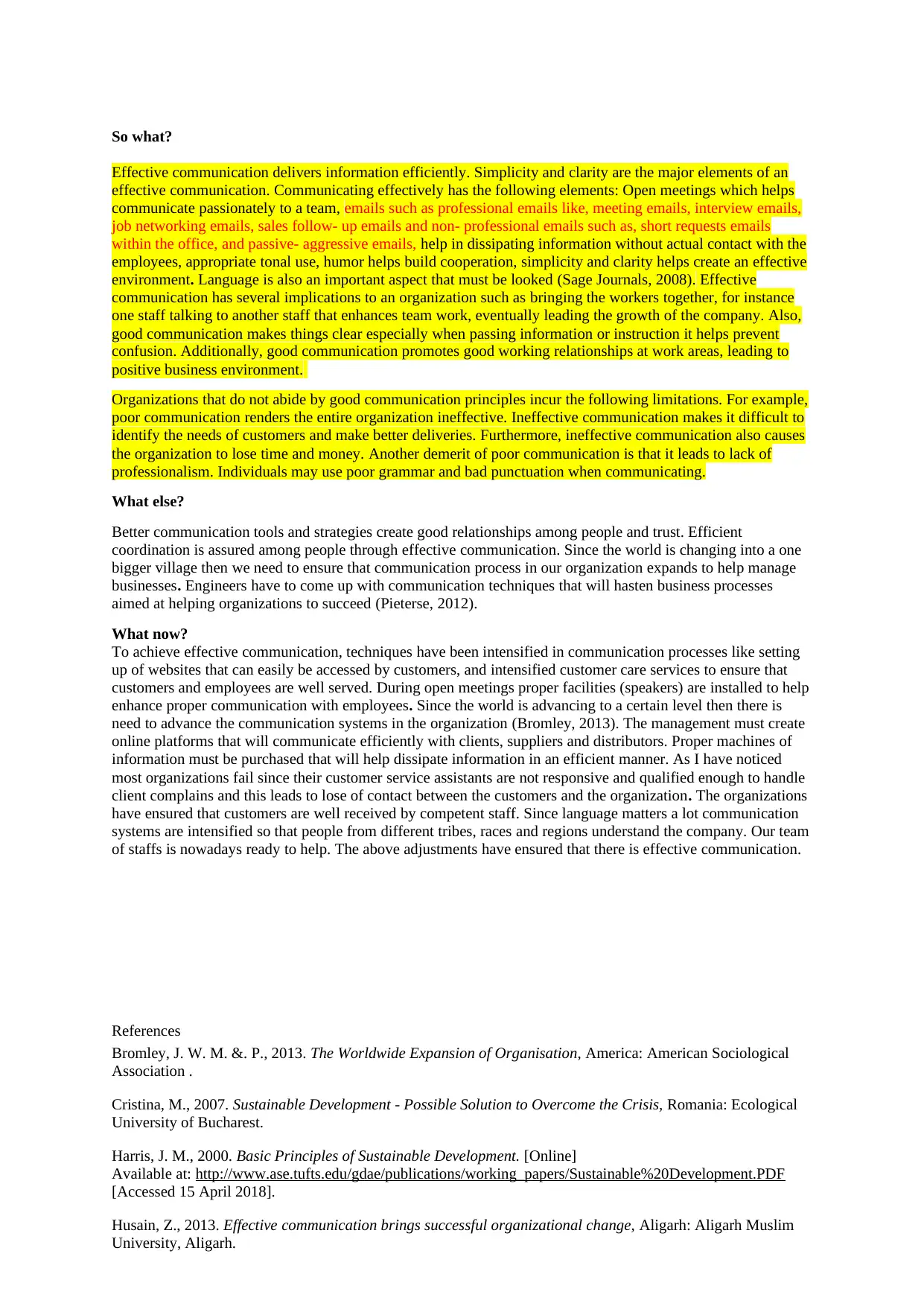
So what?
Effective communication delivers information efficiently. Simplicity and clarity are the major elements of an
effective communication. Communicating effectively has the following elements: Open meetings which helps
communicate passionately to a team, emails such as professional emails like, meeting emails, interview emails,
job networking emails, sales follow- up emails and non- professional emails such as, short requests emails
within the office, and passive- aggressive emails, help in dissipating information without actual contact with the
employees, appropriate tonal use, humor helps build cooperation, simplicity and clarity helps create an effective
environment. Language is also an important aspect that must be looked (Sage Journals, 2008). Effective
communication has several implications to an organization such as bringing the workers together, for instance
one staff talking to another staff that enhances team work, eventually leading the growth of the company. Also,
good communication makes things clear especially when passing information or instruction it helps prevent
confusion. Additionally, good communication promotes good working relationships at work areas, leading to
positive business environment.
Organizations that do not abide by good communication principles incur the following limitations. For example,
poor communication renders the entire organization ineffective. Ineffective communication makes it difficult to
identify the needs of customers and make better deliveries. Furthermore, ineffective communication also causes
the organization to lose time and money. Another demerit of poor communication is that it leads to lack of
professionalism. Individuals may use poor grammar and bad punctuation when communicating.
What else?
Better communication tools and strategies create good relationships among people and trust. Efficient
coordination is assured among people through effective communication. Since the world is changing into a one
bigger village then we need to ensure that communication process in our organization expands to help manage
businesses. Engineers have to come up with communication techniques that will hasten business processes
aimed at helping organizations to succeed (Pieterse, 2012).
What now?
To achieve effective communication, techniques have been intensified in communication processes like setting
up of websites that can easily be accessed by customers, and intensified customer care services to ensure that
customers and employees are well served. During open meetings proper facilities (speakers) are installed to help
enhance proper communication with employees. Since the world is advancing to a certain level then there is
need to advance the communication systems in the organization (Bromley, 2013). The management must create
online platforms that will communicate efficiently with clients, suppliers and distributors. Proper machines of
information must be purchased that will help dissipate information in an efficient manner. As I have noticed
most organizations fail since their customer service assistants are not responsive and qualified enough to handle
client complains and this leads to lose of contact between the customers and the organization. The organizations
have ensured that customers are well received by competent staff. Since language matters a lot communication
systems are intensified so that people from different tribes, races and regions understand the company. Our team
of staffs is nowadays ready to help. The above adjustments have ensured that there is effective communication.
References
Bromley, J. W. M. &. P., 2013. The Worldwide Expansion of Organisation, America: American Sociological
Association .
Cristina, M., 2007. Sustainable Development - Possible Solution to Overcome the Crisis, Romania: Ecological
University of Bucharest.
Harris, J. M., 2000. Basic Principles of Sustainable Development. [Online]
Available at: http://www.ase.tufts.edu/gdae/publications/working_papers/Sustainable%20Development.PDF
[Accessed 15 April 2018].
Husain, Z., 2013. Effective communication brings successful organizational change, Aligarh: Aligarh Muslim
University, Aligarh.
Effective communication delivers information efficiently. Simplicity and clarity are the major elements of an
effective communication. Communicating effectively has the following elements: Open meetings which helps
communicate passionately to a team, emails such as professional emails like, meeting emails, interview emails,
job networking emails, sales follow- up emails and non- professional emails such as, short requests emails
within the office, and passive- aggressive emails, help in dissipating information without actual contact with the
employees, appropriate tonal use, humor helps build cooperation, simplicity and clarity helps create an effective
environment. Language is also an important aspect that must be looked (Sage Journals, 2008). Effective
communication has several implications to an organization such as bringing the workers together, for instance
one staff talking to another staff that enhances team work, eventually leading the growth of the company. Also,
good communication makes things clear especially when passing information or instruction it helps prevent
confusion. Additionally, good communication promotes good working relationships at work areas, leading to
positive business environment.
Organizations that do not abide by good communication principles incur the following limitations. For example,
poor communication renders the entire organization ineffective. Ineffective communication makes it difficult to
identify the needs of customers and make better deliveries. Furthermore, ineffective communication also causes
the organization to lose time and money. Another demerit of poor communication is that it leads to lack of
professionalism. Individuals may use poor grammar and bad punctuation when communicating.
What else?
Better communication tools and strategies create good relationships among people and trust. Efficient
coordination is assured among people through effective communication. Since the world is changing into a one
bigger village then we need to ensure that communication process in our organization expands to help manage
businesses. Engineers have to come up with communication techniques that will hasten business processes
aimed at helping organizations to succeed (Pieterse, 2012).
What now?
To achieve effective communication, techniques have been intensified in communication processes like setting
up of websites that can easily be accessed by customers, and intensified customer care services to ensure that
customers and employees are well served. During open meetings proper facilities (speakers) are installed to help
enhance proper communication with employees. Since the world is advancing to a certain level then there is
need to advance the communication systems in the organization (Bromley, 2013). The management must create
online platforms that will communicate efficiently with clients, suppliers and distributors. Proper machines of
information must be purchased that will help dissipate information in an efficient manner. As I have noticed
most organizations fail since their customer service assistants are not responsive and qualified enough to handle
client complains and this leads to lose of contact between the customers and the organization. The organizations
have ensured that customers are well received by competent staff. Since language matters a lot communication
systems are intensified so that people from different tribes, races and regions understand the company. Our team
of staffs is nowadays ready to help. The above adjustments have ensured that there is effective communication.
References
Bromley, J. W. M. &. P., 2013. The Worldwide Expansion of Organisation, America: American Sociological
Association .
Cristina, M., 2007. Sustainable Development - Possible Solution to Overcome the Crisis, Romania: Ecological
University of Bucharest.
Harris, J. M., 2000. Basic Principles of Sustainable Development. [Online]
Available at: http://www.ase.tufts.edu/gdae/publications/working_papers/Sustainable%20Development.PDF
[Accessed 15 April 2018].
Husain, Z., 2013. Effective communication brings successful organizational change, Aligarh: Aligarh Muslim
University, Aligarh.
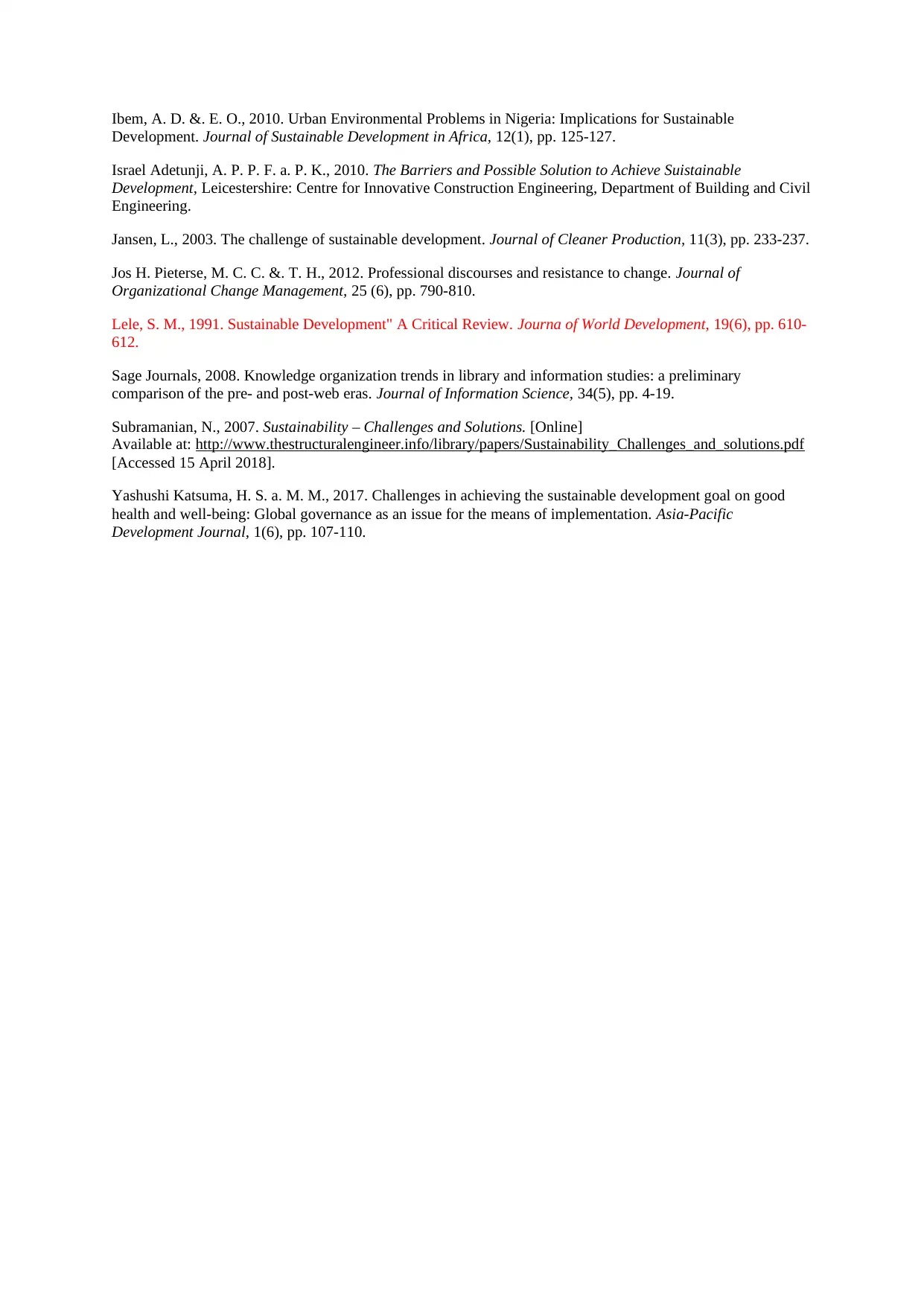
Ibem, A. D. &. E. O., 2010. Urban Environmental Problems in Nigeria: Implications for Sustainable
Development. Journal of Sustainable Development in Africa, 12(1), pp. 125-127.
Israel Adetunji, A. P. P. F. a. P. K., 2010. The Barriers and Possible Solution to Achieve Suistainable
Development, Leicestershire: Centre for Innovative Construction Engineering, Department of Building and Civil
Engineering.
Jansen, L., 2003. The challenge of sustainable development. Journal of Cleaner Production, 11(3), pp. 233-237.
Jos H. Pieterse, M. C. C. &. T. H., 2012. Professional discourses and resistance to change. Journal of
Organizational Change Management, 25 (6), pp. 790-810.
Lele, S. M., 1991. Sustainable Development" A Critical Review. Journa of World Development, 19(6), pp. 610-
612.
Sage Journals, 2008. Knowledge organization trends in library and information studies: a preliminary
comparison of the pre- and post-web eras. Journal of Information Science, 34(5), pp. 4-19.
Subramanian, N., 2007. Sustainability – Challenges and Solutions. [Online]
Available at: http://www.thestructuralengineer.info/library/papers/Sustainability_Challenges_and_solutions.pdf
[Accessed 15 April 2018].
Yashushi Katsuma, H. S. a. M. M., 2017. Challenges in achieving the sustainable development goal on good
health and well-being: Global governance as an issue for the means of implementation. Asia-Pacific
Development Journal, 1(6), pp. 107-110.
Development. Journal of Sustainable Development in Africa, 12(1), pp. 125-127.
Israel Adetunji, A. P. P. F. a. P. K., 2010. The Barriers and Possible Solution to Achieve Suistainable
Development, Leicestershire: Centre for Innovative Construction Engineering, Department of Building and Civil
Engineering.
Jansen, L., 2003. The challenge of sustainable development. Journal of Cleaner Production, 11(3), pp. 233-237.
Jos H. Pieterse, M. C. C. &. T. H., 2012. Professional discourses and resistance to change. Journal of
Organizational Change Management, 25 (6), pp. 790-810.
Lele, S. M., 1991. Sustainable Development" A Critical Review. Journa of World Development, 19(6), pp. 610-
612.
Sage Journals, 2008. Knowledge organization trends in library and information studies: a preliminary
comparison of the pre- and post-web eras. Journal of Information Science, 34(5), pp. 4-19.
Subramanian, N., 2007. Sustainability – Challenges and Solutions. [Online]
Available at: http://www.thestructuralengineer.info/library/papers/Sustainability_Challenges_and_solutions.pdf
[Accessed 15 April 2018].
Yashushi Katsuma, H. S. a. M. M., 2017. Challenges in achieving the sustainable development goal on good
health and well-being: Global governance as an issue for the means of implementation. Asia-Pacific
Development Journal, 1(6), pp. 107-110.
⊘ This is a preview!⊘
Do you want full access?
Subscribe today to unlock all pages.

Trusted by 1+ million students worldwide

© Dr Kalam Azad
1 out of 7
Related Documents
Your All-in-One AI-Powered Toolkit for Academic Success.
+13062052269
info@desklib.com
Available 24*7 on WhatsApp / Email
![[object Object]](/_next/static/media/star-bottom.7253800d.svg)
Unlock your academic potential
Copyright © 2020–2025 A2Z Services. All Rights Reserved. Developed and managed by ZUCOL.





